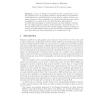Free Online Productivity Tools
i2Speak
i2Symbol
i2OCR
iTex2Img
iWeb2Print
iWeb2Shot
i2Type
iPdf2Split
iPdf2Merge
i2Bopomofo
i2Arabic
i2Style
i2Image
i2PDF
iLatex2Rtf
Sci2ools
CSR
2009
Springer
2009
Springer
A Feebly Secure Trapdoor Function
Abstract. In 1992, A. Hiltgen [1] provided the first constructions of provably (slightly) secure cryptographic primitives, namely feebly one-way functions. These functions are provably harder to invert than to compute, but the complexity (viewed as circuit complexity over circuits with arbitrary binary gates) is amplified by a constant factor only (with the factor approaching 2). In traditional cryptography, one-way functions are the basic primitive of privatekey and digital signature schemes, while public-key cryptosystems are constructed with trapdoor functions. We continue Hiltgen’s work by providing an example of a feebly trapdoor function where the adversary is guaranteed to spend more time than every honest participant by a constant factor of 25 22 .
| Added | 26 May 2010 |
| Updated | 26 May 2010 |
| Type | Conference |
| Year | 2009 |
| Where | CSR |
| Authors | Edward A. Hirsch, Sergey I. Nikolenko |
Comments (0)

